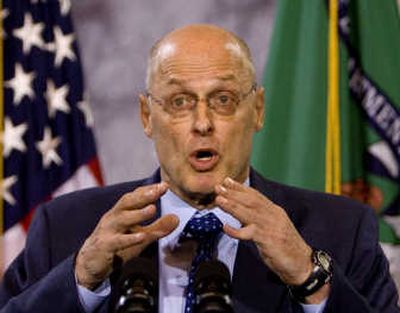Regulation overhaul plan offers little help soon

WASHINGTON — A vast reshuffling of U.S. financial regulators pitched by Treasury Secretary Henry Paulson on Monday is not so much about today’s economic crisis as tomorrow’s.
The plan Paulson unveiled stirs the alphabet stew of federal and state regulators that oversee banks and other financial institutions, but fails to catch the credit market’s recent breakdowns. The proposal would force states to cede much of their power over banks and insurance companies to federal authorities, put hedge funds and private equity investors under new regulations and create a consumer-protection agency with sway over anyone offering to invest your money.
What it does not offer: new solutions for people facing foreclosures or short-term relief for the economy.
And the plan comes with a paradox: While touting the need for broad new bureaucratic powers to improve financial markets, Paulson said the economy’s current stumbles had nothing to do with lax regulation, something critics have long questioned.
“I am not suggesting that more regulation is the answer, or even that more effective regulation can prevent the periods of financial market stress that seem to occur every five to 10 years,” he said Monday.
While some leading Democrats praised Paulson’s directions, many were critical, and all sides noted the slim-to-none chance of major changes becoming law during the twilight of the Bush administration.
“The administration’s hands-off policies on regulation of securities and commodities markets and its continued pressure for less and less regulation have contributed to the mess that the markets are in,” U.S. Sen. Carl Levin, D-Mich., said in a statement. “Reasonable regulation, not just coordination, of those markets is overdue.”
Many of the federal financial overseers were created in the wake of the Great Depression to stabilize banks and home lenders. But since the late 1970s, financial markets have developed increasingly complex ways of making money – from stock futures to credit-default swaps – that don’t fit into laws written in the 1930s.
Meanwhile, banks, investment companies and insurance firms blurred the lines among their businesses that freed some new competitors from rules that established firms had to follow. Those changes have also tangled the lines of authority between state and federal regulators; the U.S. Supreme Court ruled last year that Michigan could not apply its mortgage broker regulations to an arm of Wachovia Bank because the bank had a federal charter.
The biggest change in Paulson’s plan would regulate financial firms by what they do, instead of by whether they’re a bank, insurer or hedge fund.
The Federal Reserve would have broader power to stabilize markets, as it did with the collapse of Bear Stearns last month. And a new agency would write and enforce consumer and investor protection rules, combining some of the powers of the U.S. Securities and Exchange Commission.
New federal offices would also oversee mortgage brokers and insurance firms, replacing state-level regulators.